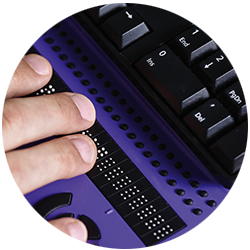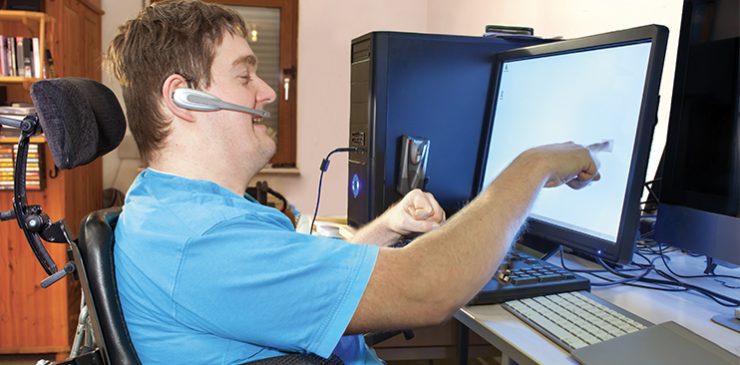More and more people are “telecommuting” and working away from traditional offices, including people with disabilities. Innovations in technology and furniture design have made it possible for everyone to work from home.
The Rick Hansen Foundation, in one of their recent initiatives, turned an inaccessible office into one that accommodates people who use wheelchairs. In their design, they opted for an open-concept layout that allowed wheelchair users to have space to turn around, lots of natural light and electric adjustable-height desks.
I reached out to Jim Lorefice, the founder of Top Lawyers. The company is headquartered on Bloor Street in Toronto, but Jim handles his responsibilities from his home office. I asked Jim to describe his accessible home office and what advice he has for someone setting up their own office:
“A home office has so many advantages. Not having to commute is a huge time saver and gain in productivity. Not having to worry about parking or accessibility issues is another plus. In terms of my home office setup and advice I would offer… Ikea and technology are your best friends.
My home office furniture is all Ikea. Their clever designs lend themselves to ease of use by anybody regardless of ability. In terms of accommodating my needs, I love my height adjustable desk. In terms of technology, it’s such an equalizer. My advice to others would be to not skimp on the tech that boosts your productivity and puts you on a level playing field with your able-bodied peers. My PC is a beast. It allows me to run the demanding programs I use including a web server for offline website builds. Two items I couldn’t be without are my Bluetooth headset and Blue microphone. The headset allows me to communicate clearly, handling calls and the mic is amazing for online collaboration and speech to text.
Whatever your setup, make sure you are comfortable. You’re going to need to put in the time to find success.”
Research has shown that in the last 15 years, there has been an increase in the initiatives to help those with severe disabilities enter the job market. And I think having the option of telecommuting can provide great benefits:
- Less stress related to getting to and from work
- Flexible schedule
- Personal needs can be more easily taken care of
The first stage in designing a home office space is deciding what you need. One person’s office layout may not be suitable for everyone so take the time to plan. Good design will lead to an efficient and accessible space.
Looking at what your job entails is also important. Will you need to talk on the phone, video conference, read emails and write documents? These tasks can all be done from home.
Novalte is a company that has created a device called Emitto to help users be more independent at home. This customizable system can be activated by voice, breathing tube, joystick or other means of movement. With a device no bigger than a smartphone, it can be connected to all systems around your home and home office including air conditioner, heating, doors, lighting and phone.
 Adaptive computing refers to a computer system, both hardware and software, that can be customized for people with disabilities. An example of adaptive computing is the JAWS program which was developed for computer users with vision loss. JAWS acts as a screen reader that reads the text on your screen. It allows the user to surf the internet, write a document and read and respond to emails. It can also be connected via Bluetooth to a braille embosser. This device has the ability to change the raised dots on a device based on what is happening on the screen so the user can follow along and navigate.
Adaptive computing refers to a computer system, both hardware and software, that can be customized for people with disabilities. An example of adaptive computing is the JAWS program which was developed for computer users with vision loss. JAWS acts as a screen reader that reads the text on your screen. It allows the user to surf the internet, write a document and read and respond to emails. It can also be connected via Bluetooth to a braille embosser. This device has the ability to change the raised dots on a device based on what is happening on the screen so the user can follow along and navigate.
Other examples of adaptive computing can include sip and puff systems that are activated by inhaling or exhaling; joysticks that can be controlled by hand, feet or chin; and wands that can press keys on a keyboard and can be worn on the head, held in the mouth or strapped to the chin.
The lighting in your home office is very important. Natural light promotes job performance and enhances overall well-being according to a survey done by Harvard Business Review. Opting for a bigger window instead of an overhead light is proven to make working at home just that much more comfortable. If a big window isn’t possible, try incorporating a variety of lighting options. Easy to reach switches that are motion detected or activated by voice can be used. And desk lamps for reading and closet lighting should be considered too.
Storage in your office is important too. You want to be able to reach all areas within the storage space. Whether that means taking the doors off a closet or having low shelves, it is worth planning.
After figuring out your personal and work needs, the final stage is choosing the furniture and planning the layout of the room. Make sure you have a desk that is the right height and there is adequate space to maneuver within the room. If you have vision loss, try placing different textures to guide you to places like your chair and computer. These can include a strip of carpet along the wall leading to your desk or raised bumps to indicate where certain items are stored.
The goal is independence and productivity from your home office but that doesn’t mean it has to be boring. Find furniture and decorations that fit your style, and make you want to spend time there. Taking the extra time to design a space that is accessible and enjoyable will be worth it.
 Jeffrey Kerr, Broker, Barrier Free Real Estate Specialist
Jeffrey Kerr, Broker, Barrier Free Real Estate Specialist
RE/MAX Unique Inc., Brokerage
416-424-2222
www.AccessibleHomeFinder.com
Facebook: @AccessibleHomeFinder.com
Twitter: @barrierfreeRE






